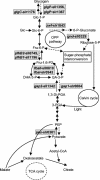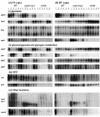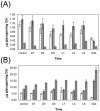Pleiotropic effect of a histidine kinase on carbohydrate metabolism in Synechocystis sp. strain PCC 6803 and its requirement for heterotrophic growth
- PMID: 15774880
- PMCID: PMC1065225
- DOI: 10.1128/JB.187.7.2368-2376.2005
Pleiotropic effect of a histidine kinase on carbohydrate metabolism in Synechocystis sp. strain PCC 6803 and its requirement for heterotrophic growth
Abstract
The deletion of a gene coding for a histidine kinase (sll0750, Hik8) in the unicellular cyanobacterium Synechocystis sp. strain PCC 6803 resulted in a conditional lethal phenotype with a pleiotropic effect on the expression of genes involved in glucose metabolism. This mutant had comparable doubling times to wild type (WT) in continuous-light-grown photoautotrophic and mixotrophic cultures, whereas it grew poorly under mixotrophic conditions with different light and dark cycles. Growth was completely stopped, and cells eventually died, when the light duration was less than 6 h on a 24-h regimen. Northern blot analysis demonstrated that steady-state transcript levels of genes encoding key enzymes of glycolysis, gluconeogenesis, the oxidative pentose phosphate pathway, and glycogen metabolism were significantly altered in a strain with mutant hik8 (Deltahik8) grown with or without glucose. In some cases, differential expression was dependent on growth conditions (photoautotrophic versus mixotrophic). The enzyme activities of glucose-6-phosphate dehydrogenase, 6-phosphogluconate dehydrogenase, and phosphofructokinase were significantly reduced in Deltahik8 compared to WT. Glycogen determination indicated that Deltahik8 accumulated glycogen under mixotrophic conditions but was unable to utilize these reserves for heterotrophic growth. The results suggest that the loss of gap1 transcription in the absence of Hik8 was the key factor that rendered cells unable to catabolize glucose and grow heterotrophically. Additionally, the transcript levels of the phytochrome gene (cph1) and its cotranscribed response regulator gene (rcp1) were significantly reduced and its dark inducibility was lost in Deltahik8. The results demonstrated that Hik8 plays an important role in glucose metabolism and is necessary for heterotrophic growth.
Figures





Similar articles
-
Alteration of cyanobacterial sugar and amino acid metabolism by overexpression hik8, encoding a KaiC-associated histidine kinase.Environ Microbiol. 2015 Jul;17(7):2430-40. doi: 10.1111/1462-2920.12715. Epub 2015 Jan 27. Environ Microbiol. 2015. PMID: 25403325
-
Genes for a series of proteins that are involved in glucose catabolism are upregulated by the Hik8-cascade in Synechocystis sp. PCC 6803.Planta. 2015 Jun;241(6):1453-62. doi: 10.1007/s00425-015-2270-z. Epub 2015 Mar 3. Planta. 2015. PMID: 25732003
-
Positive regulation of sugar catabolic pathways in the cyanobacterium Synechocystis sp. PCC 6803 by the group 2 sigma factor sigE.J Biol Chem. 2005 Sep 2;280(35):30653-9. doi: 10.1074/jbc.M505043200. Epub 2005 Jun 8. J Biol Chem. 2005. PMID: 15944148
-
Post-translational Modifications of Serine/Threonine and Histidine Kinases and Their Roles in Signal Transductions in Synechocystis Sp. PCC 6803.Appl Biochem Biotechnol. 2021 Mar;193(3):687-716. doi: 10.1007/s12010-020-03435-2. Epub 2020 Nov 6. Appl Biochem Biotechnol. 2021. PMID: 33159456 Review.
-
Sequences, Domain Architectures, and Biological Functions of the Serine/Threonine and Histidine Kinases in Synechocystis sp. PCC 6803.Appl Biochem Biotechnol. 2019 Aug;188(4):1022-1065. doi: 10.1007/s12010-019-02971-w. Epub 2019 Feb 19. Appl Biochem Biotechnol. 2019. PMID: 30778824 Review.
Cited by
-
The proteome and lipidome of Synechocystis sp. PCC 6803 cells grown under light-activated heterotrophic conditions.Mol Cell Proteomics. 2015 Mar;14(3):572-84. doi: 10.1074/mcp.M114.042382. Epub 2015 Jan 5. Mol Cell Proteomics. 2015. PMID: 25561504 Free PMC article.
-
Transcriptional regulation of the respiratory genes in the cyanobacterium Synechocystis sp. PCC 6803 during the early response to glucose feeding.Plant Physiol. 2007 Nov;145(3):1018-30. doi: 10.1104/pp.107.105023. Epub 2007 Sep 7. Plant Physiol. 2007. PMID: 17827271 Free PMC article.
-
Global transcriptional response of the alkali-tolerant cyanobacterium Synechocystis sp. strain PCC 6803 to a pH 10 environment.Appl Environ Microbiol. 2008 Sep;74(17):5276-84. doi: 10.1128/AEM.00883-08. Epub 2008 Jul 7. Appl Environ Microbiol. 2008. PMID: 18606800 Free PMC article.
-
Mapping photoautotrophic metabolism with isotopically nonstationary (13)C flux analysis.Metab Eng. 2011 Nov;13(6):656-65. doi: 10.1016/j.ymben.2011.08.002. Epub 2011 Sep 1. Metab Eng. 2011. PMID: 21907300 Free PMC article.
-
Integrative analysis of large scale expression profiles reveals core transcriptional response and coordination between multiple cellular processes in a cyanobacterium.BMC Syst Biol. 2010 Aug 2;4:105. doi: 10.1186/1752-0509-4-105. BMC Syst Biol. 2010. PMID: 20678200 Free PMC article.
References
-
- Bradford, M. M. 1976. A rapid and sensitive method for the quantitation of microgram quantities of protein utilizing the principle of protein-dye binding. Anal. Biochem. 72:248-254. - PubMed
-
- Daldal, F. 1983. Molecular cloning of the gene for phosphofructokinase-2 of Escherichia coli and the nature of a mutation, pfkB1, causing a high level of the enzyme. J. Mol. Biol. 168:285-305. - PubMed
-
- Figge, R. M., C. Cassier-Chauvat, F. Chauvat, and R. Cerff. 2000. The carbon metabolism-controlled Synechocystis gap2 gene harbours a conserved enhancer element and a gram-positive-like −16 promoter box retained in some chloroplast genes. Mol. Microbiol. 36:44-54. - PubMed
Publication types
MeSH terms
Substances
LinkOut - more resources
Full Text Sources
Molecular Biology Databases

